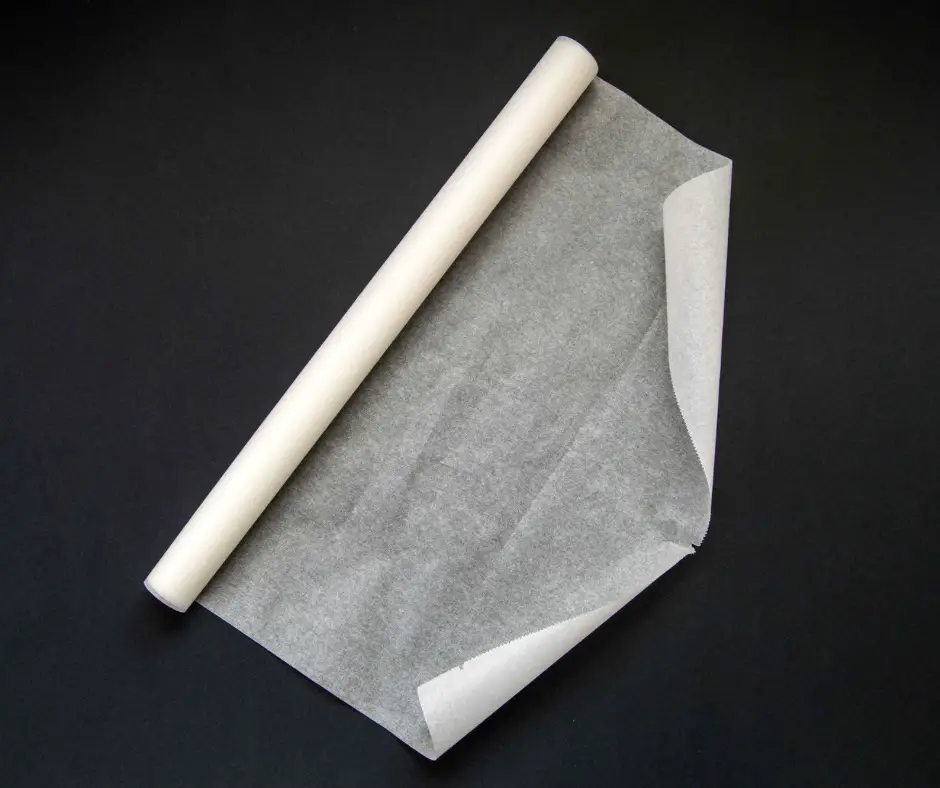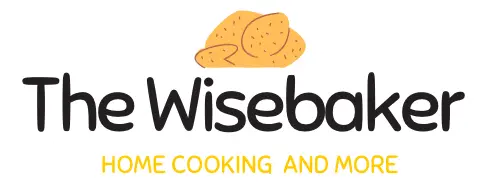When it comes to storing and packing food items, we often use different materials, such as glass, plastic, paper, ceramic and metal.
But not all of these materials can handle microwave cooking.
Some of them have components or coatings that can’t stand high heat and can melt or release harmful substances into food when microwaved.
That’s why it’s essential to check the microwave compatibility of any material before putting it in the oven. This will help avoid any chemical contamination of food or a potential microwave risk.
In this article, we’ll focus on wax paper and whether it can go in the microwave. We’ll also give you a list of common materials that are safe or unsafe to use in the microwave.
At the end, you’ll also learn how to test any container at home to see if it’s microwave-safe or not.

Is it Safe to Microwave Wax Paper?
You can use wax paper in the microwave as long as you don’t use it to wrap foods that have a lot of fat and oil in them.
Wax paper is usually unaffected by microwave radiation because its molecules don’t absorb it. So, it doesn’t get hot from the radiation itself, but only from the food that gets heated by the radiation.
Some foods that have a lot of fat and oil can easily get hotter than 200°F, which can make the wax on the paper melt and even make the paper itself catch fire.
Here’s Why Wax Paper Is Transparent to Microwave Radiation
Microwave ovens work by emitting low-energy microwave radiation that can be absorbed by some molecules in food and turned into heat for cooking.
Microwave radiation makes molecules rotate, so any molecule that can absorb its energy will spin and bump into other nearby molecules, creating friction and heat.
Some examples of substances in food that can absorb microwave radiation are water, fats, oils, sugar, and salt. They can do so because their molecules meet two criteria for microwave absorption:
- They have the same rotational and vibrational energies as the microwave radiation.
- They have the ability to interact with the microwave radiation and take its energy and produce heat.
Wax paper, on the other hand, mostly consists of particles that don’t meet these criteria, so the paper as a whole appears transparent to the microwave radiation and lets it pass through with little to no interference.
Other materials that also appear transparent to microwave radiation include air, ice, parchment paper, glass, ceramics, plastics, and paper towels. Some of these materials are used to make microwave-safe containers or covers.
Papers, ceramics, and other materials that are used as food containers or covers in microwave ovens don’t get heated directly by the microwave radiation, but rather from the food that gets heated by the radiation.
Therefore, only food and not microwave radiation can actually heat wax paper to the point where it falls apart i.e. melting of the wax coating.
But this rarely happens with water-based foods because they hardly ever go above 212°F on their surface. This is because of the evaporative cooling of their surface by the cold air in the oven.
Another factor is the significant moisture accumulation on the surface of the food, which lowers the surface temperature of the food and also wets the inside of the wax paper, making it hard to reach temperatures high enough to trigger any melting of the wax.
However, food items that are very high in fat and oil can easily go above 170°F on their surface, which is enough to melt the wax coating on the paper.
Burnt foods can also raise the temperature of wax paper beyond its melting point and can even cause instant smoking or burning of the paper. So, make sure you never leave food items (covered with wax paper) to burn in the microwave!
Can wax paper leach any toxic substance into food during microwaving?
Wax paper comes in two types: bleached and unbleached.
Bleached wax paper has a bright white color that comes from a chemical bleaching process that uses chlorine. This process can produce trace amounts of toxic dioxins as byproducts, which can remain in the final product and potentially migrate into food during cooking.
According to this old fact sheet and this case study, the amounts of dioxins transferred into food from chlorine-bleached papers are insignificant and pose no health risk.
However, according to the World Health Organization, dioxins are very persistent and highly toxic chemicals that can accumulate in the fatty tissues of the body for 7 to 11 years.
This means that the small amounts of dioxins that get into food during cooking can build up to toxic levels over time and cause health problems.
It’s better to be safe than sorry and avoid using chlorine-bleached products for your health and the environment.
You can read more about dioxins from this report by the World Health Organization.
Is the wax coating on wax paper harmful?
No, it’s not. The wax coating on wax paper is made from edible wax (soy or paraffin) which means that it’s harmless if you eat it.
The only downside to the “wax paper leaching into food” thing is the weird taste that it gives to whatever you’re cooking. So whether it’s a sweet, savory, or spicy dish, wax paper can easily mess with the flavors and make them taste off!
Why do Fats and oils reach higher temperatures and melt wax coating?
It’s because of their lower specific heat capacity. This allows them to reach higher temperatures compared to other substances for the same amount of heat generated.
What are the safety tips for using wax paper in the microwave?
Generally speaking, wax paper is most safe when employed as a lid to prevent microwave mess. It hardly makes any contact with food so the risks of melting or burning is greatly reduced.
Moreover, this is how most brands would expect you to use their wax paper! Not by popping them in the oven or wrapping them around high fat contents at microwave HIGH!
But that doesn’t mean wax paper cannot be used to wrap foods for microwave cooking. It just needs to wrap the right kind of food for the right kind of situation.
Water based food like steak, fruits and garlic, at average microwaving conditions, won’t heat up a wax paper to the point where the wax coating begins to melt off. Foods with normal amount of fats or oils would also be fine to wrap in wax paper.
But foods with very high amounts of fats, oils, or salt can easily melt the wax coating on wax paper and transfer it into the food.
A perfect substitute for this scenario would be parchment paper since it has undergone tough treatments and processes and is thus easily able to withstand temperatures upto 450°F. (That’s nearly the cooking temperature for high heat turkey!).
Secondly, make sure to always purchase wax paper from a reliable brand. This will ensure that you’re wrapping the right kind of quality over your cheese or potatoes.
Lastly, avoid using wax paper for too long in the microwave. The wax can eventually melt off. In these situations, it’s best to stick with parchment paper or microwaveable lids.
What to use wax paper for in a microwave oven?
Use wax paper for the following in a microwave oven.
- Reheat leftovers: Place the wax paper over a microwave-safe container to prevent contamination and splatter of food as they cook. This would ease up cleaning by a mileage!
- Use wax paper as a pouch for cooking foods such as salmon, potato, corn, garlic, vegetables, scrambled eggs, banana etc.
- Use wax paper as a lid for cooking in the microwave. This ensures even heating and therefore cooking.
- Use wax paper as a plate liner when cooking greasy foods such as bacon. Be careful though as this is one food item that can easily melt the wax coating on wax paper.
- Use wax paper as a pan liner for baking cakes and bread in the microwave oven.
- Cover foods meant to be defrosted in the microwave oven with a sheet of wax paper to ensure even heating.
Is It Better to Microwave Parchment Paper or Wax Paper?
Parchment paper is sturdier and stronger than wax paper, and it has a silicone coating instead of wax. So, it’s always better to microwave parchment paper instead of wax paper.
Is It Okay to Boil Wax Paper?
No, it is not okay to boil wax paper. because it is coated with paraffin wax, which makes it non-stick and moisture-resistant, but not heat-resistant.
If you boil wax paper, the wax will melt and mix with the water, and the paper itself may disintegrate or catch fire.
If you want to use a paper that is safe and effective for boiling or baking foods, parchment paper is a better choice than wax paper because it is coated with silicone, which makes it non-stick and heat resistant.
You can use parchment paper to line baking dishes, wrap foods, or cook foods in boiling water or in the oven. Parchment paper can withstand high temperatures and won’t melt or catch fire.
What other things can you put in the microwave oven?
You can use these common items in the microwave oven without any problem.
- Any utensil, container or wrap labelled safe for microwave use.
- Parchment paper.
- Glass-ceramic material.
- Baking mats.
- Oven cooking bags.
- Glass, ceramics and plastics containers and wraps with a clear microwave safe label.
- White paper plates, towels, napkins, bags and bowls.
- Styrofoam; Do not use Styrofoam for fatty, oily foods, soups, or noodles.
- Pyrex.
- Straw or wooden basket.
What materials are not safe to put in the microwave oven?
You should never microwave these items because they can cause sparks, fires, or harmful chemicals.
- Any utensil, container or wrap labelled not safe for microwave use.
- Thin plastic storage bags.
- Brown paper bags.
- Plastic grocery bags.
- Newspapers.
- Aluminum foil: they are only safe to use in small amounts, like when shielding small areas of poultry food to prevent over cooking.
- Metal pans.
- Recycled materials.
- One time food containers i.e. yogurt cartons and margarine tubs.
- Foam insulated cups, bowls, plates or trays.
- Anything with metallic rim or handles.
- Metal twist ties.
- Warped or melted containers.
How to tell if a container is safe to use in the microwave oven
Fill a glass cup with 1 cup of water. Put the glass cup and the container you want to test next to each other in the microwave oven. Heat at any setting for 1 minute. If the test container feels warm or hot, don’t use it.
